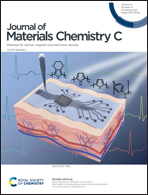MEA surface passivation of a AgNWs:SnO2 composite transparent electrode enables efficient flexible ITO-free polymer solar cells†
Abstract
Solution-processible and flexible transparent electrodes are highly required for polymer solar cells (PSCs) to accommodate their roll-to-roll manufacturing. Herein, we present a kind of solution-processed silver nanowire (AgNW)-based composite transparent electrode fabricated using blade-coating a SnO2 hydrocolloid and a AgNW aqueous dispersion. The resultant AgNWs:SnO2 composite film demonstrates a smooth surface morphology as the AgNW networks are well covered by colloidal SnO2. The AgNWs:SnO2 transparent film attains a sheet resistance of ca. 17 ohm per square and a high transmittance of ca. 92% at 550 nm. Inverted PSCs without additional cathode buffer layers are fabricated based on the AgNWs:SnO2 composite transparent electrode and a power conversion efficiency (PCE) of 12% is attained. Furthermore, an organic solvent monoethanolamine (MEA) is used to passivate the surface defects of the AgNWs:SnO2 electrode via blade coating. The number of hydroxyl groups on the surface of the AgNWs:SnO2 composite electrode is effectively reduced and the PCE of the inverted PSCs is enhanced to 13.5%, benefitting from an increased short-circuit current density (JSC) and fill factor (FF). The synergistic enhancement of JSC and FF is attributed to the improved charge extraction and decreased defect-induced recombination at the cathode–active layer interfaces by MEA modification. Flexible PSCs based on the MEA-modified AgNWs:SnO2 composite transparent electrode are fabricated via blade-coating and a PCE of 13.0% is attained. The device shows good flexibility with the PCE retaining 80% of its initial value after 500 bending cycles with a bending radius of 5 mm.



 Please wait while we load your content...
Please wait while we load your content...